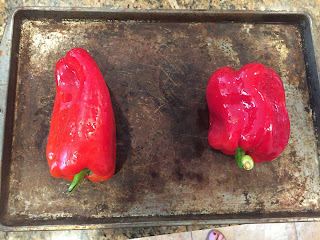I have always enjoyed learning about other places. When I was in my middle elementary school years, I could amuse myself for hours on end with a tablet of tracing paper and a set of encyclopedias. I enjoyed learning about different states and countries, and I particularly enjoyed tracing and coloring the maps.
When I was in the third grade, I was in a combined class that included all of the third graders and half of the fourth graders. One of the fourth graders' assignments was to write a report on a given state. I decided that I didn't want to be left out and asked my teacher if I could write a state report, too. He agreed, and I was delighted to prepare a report on Alaska, the state where I was born.
Fast forward nearly 40 years to late 2015. While visiting my local quilt shop, I learned of a Block-of-the-Month pattern that would be released in 2016. This project was a quilt made of fabrics featuring the state flowers of each of the 50 states. I very quickly put my name on the list to be included.
From January through May 2016, each month I received fabric to make 10 blocks. At the end of May, I was ready to put the quilt together. As you can see from the picture at the top of this posting, this is a HUGE quilt. It measures 86.5 x 102.5 inches, so roughly a queen size quilt. The machine quilting was done by Kerrie Curtis from Utah Valley Quilting who did a great job with an all-over design that complemented the designs of the individual blocks.
The fabrics used in this quilt featured art deco-style prints. The block pattern is the granny square block, a traditional quilt block pattern that has appeared in many quilts through the years. One of the nice things about this quilt pattern is that it didn't require additional sashing strips. As the blocks were sewn together, the white triangles on the outside edges of the blocks joined together to create full size squares that gave the look of sashing between the blocks.
I thought I would share a few of the blocks with you. I've selected blocks featuring the state flowers of the states that we recently visited during our family's summer vacation. I'm starting with the Utah sego lily.
From Utah, we crossed over into Wyoming, whose state flower is the Indian paintbrush.
After a long drive through Wyoming, we crossed over into Nebraska. Their state flower is the goldenrod.
The border between Nebraska and the neighboring state of Iowa is defined by the Missouri River. Iowa's state flower is the wild prairie rose.
After a brief drive through Iowa, we reached Minnesota, home to the lady slipper.
After staying for several days in Minnesota, we needed to head for home. Our journey westward took us to North Dakota, who also selected the wild prairie rose as their state flower.
Our travels also included a few days in South Dakota. South Dakota adopted the pasque flower, also known as the May Day flower as their state flower. From South Dakota, we journeyed back through Wyoming and then home to Utah.
Although this post has featured states as physical locations that can be visited, I would also like to reflect, for a moment or two, on non-geographic states. These "states" may be considered our state of mind, state of the heart, or even our spiritual state. I will readily admit that it is easy for us to allow these "states" to be influenced by our circumstances, including other people, the weather, finances, current challenges, uncertainty within our nation or the world - really about anything. In contemplating these "states," I've found myself reflecting on Paul's words in his letter to the Philippians in which he relates his state of contentment despite the widely disparate circumstances he experienced during his ministry years. Of note, too, Paul penned these words while in prison. Perhaps they, too, will challenge you as you contemplate your own circumstances and the "state" in which you are finding yourself.
Not that I speak from want, for I have learned to be content in whatever circumstances I am. I know how to get along with humble means, and I also know how to live in prosperity; in any and every circumstance I have learned the secret of being filled and going hungry, both of having abundance and suffering need. Philippians 4:11-12















